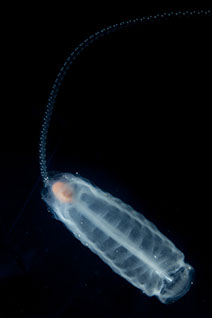Salps of the Chatham Rise (New Zealand)
Salps are unique open-ocean animals that range in size from a few millimeters to greater than twenty centimeters. They have a gelatinous (jelly-like) body, and can form long chains of many connected individuals. These oceanic organisms act as oceanic vacuum cleaners, having incredibly high feeding rates on phytoplankton and, unusual for consumers of their size, smaller bacteria-sized prey. This rapid feeding and the salps' tendency to form dense blooms, allows them move substantial amounts of prey carbon from the surface into the deep ocean, leading to carbon dioxide removal from the atmosphere. However, salps are often considered a trophic dead-end, rather than a link, in the food web due to the assumption that they themselves are not consumed, since their gelatinous bodies are less nutritious than co-occurring crustacean prey. Along with this, salp populations are hypothesized to be increasing due to climate change. In our project (funded by the National Science Foundation, in collaboration with Dr. Karen Selph from University of Hawaii and Dr. Moira Decima from NIWA) we are addressing several questions: 1) Do salps compete primarily with crustaceans (as in the prevailing paradigm) or are they competitors of single-celled protists, which are the dominant grazers of small phytoplankton? 2) Do salp blooms increase the efficiency of food-web pathways from tiny phytoplankton to fisheries production in nutrient-poor ocean regions? 3) What is the quantitative impact of salp blooms on the biological pump?
It is commonly assumed that salps are a trophic sink. However, this idea was developed before the discovery that protists (rather than crustaceans) are the dominant grazers in the open ocean and was biased by the difficulty of recognizing gelatinous salps in fish guts. More recent studies show that salps are found in guts of a diverse group of fish and seabirds and are a readily available prey source when crustacean abundance is low. Our project will quantify food web flows through contrasting salp-dominated and salp-absent water parcels near the Chatham Rise off western New Zealand where salp blooms are a predictable phenomenon. Our goal is to determine: 1) taxon- and size-specific phytoplankton growth rate measurements, 2) taxon- and size-specific protozoan and salp grazing rate measurements, 3) compound specific isotopic analysis of the amino acids of mesozooplankton to quantify the trophic position of salps, hyperiid amphipods, and other crustaceans, 4) sediment traps to quantify zooplankton carcass sinking rates, and 5) linear inverse ecosystem modeling syntheses. Secondary production and trophic flows from this well-constrained ecosystem model will be compared to crustacean-dominated and microbial loop-dominated ecosystems in similarly characterized regions (California Current, Costa Rica Dome, and Gulf of Mexico).
Our primary cruise for the project took place in November 2018. Led by chief scientist Moira Decima, we used historical records of Oreo abundance (Oreos are a species of fish native to the Chatham Rise that feed primarily on salps) to identify regions where salp blooms were likely. Guided by these records, we searched for and found extensive blooms of Salpa thompsoni (an abundant cold water salp) and conducted a series of Lagrangian experiments within the bloom and to the north and south of the bloom to contrast ecological and biogeochemical conditions in the bloom with similar regions devoid of salps. Now we have mountains of samples and two years to turn them into data!
If you would like to learn more about our cruise, please check out the cruise blog: https://www.niwa.co.nz/our-science/voyages/tan1810-ocean-vacuum-cleaner
If you want to see pictures of some of the plankton we encountered on the cruise, click through below.



















































































































Solitary stage of the salp Salpa thompsoni
Solitary Salpa thompsoni releasing a chain of blastozooids
Phronima sp.
Salpa thompsoni blastozooids
Recently released Salpa thompsoni blastozooids
Solitary Soestia zonaria releasing a chain of blastozooids
Salpa thompsoni fecal pellet
Salpa thompsoni fecal pellet
Salpa thompsoni blastozooids
Closeup of Salpa thompsoni gut and stolon
Salpa thompsoni
The giant salp Thetys vagina
Pegea confoederata
Salpa thompsoni oozooid (foreground) and chain of young S. thomsponi blastozooids (background)
Closeup of Salpa thompsoni stolon and gut
Closeup of Salpa thompsoni oozooid releasing a chain of blastozooids
16 - 115
<
>
This portion of our website is specifically designed as outreach to the general public. If you are a scientist look for details about our research, please click on the red 'For Scientists' link on the top right.
Contact: Mike Stukel (mstukel@fsu.edu)
Florida State University
Dept. of Earth, Ocean, and Atmospheric Science
Center for Ocean-Atmospheric Prediction Studies
